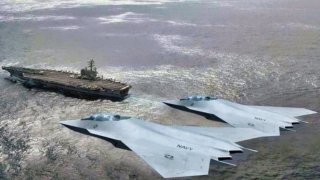F/A-XX: Why Build a New Stealth Fighter for Obsolete Aircraft Carriers?
The Navy is developing the F/A-XX alongside the Air Force’s Next Generation Air Dominance project, or NGAD. Although the NGAD and F/A-XX share some technologies, each program is distinct. Sadly, doubts remain about how the F/A-XX can proceed, considering the aircraft carrier is constantly questioned as a viable warfare platform.
Summary: In March, the U.S. Navy made a strategic decision to reduce its budget for the next-generation F/A-XX fighter program to prioritize more immediate threats, especially concerning the rising tensions with China. The F/A-XX program, which is critical as the F/A-18 Super Hornet and EA-18G Growler approach the end of their production, aims to deliver a multi-role aircraft capable of operating in contested environments. The development involves leading defense contractors and incorporates advanced technologies like Collaborative Combat Aircraft and open architecture systems. Despite budget cuts, the Navy remains committed to evolving its air superiority capabilities alongside the Air Force’s NGAD project. However, there are concerns about the high costs and the future role of aircraft carriers in a potential next-generation conflict scenario.
F/A-XX Dilemma: Navigating Budget Cuts and Technological Advances in U.S. Naval Aviation
The U.S. Navy made a tough call in March when it opted to drastically cut its budget for its next-generation fighter program. Future technologies and modernization are always critical, but given the potential for imminent conflict with China, the Navy will focus on more urgent priorities.
According to the service’s comptroller, the Navy will continue to allocate the funds it needs to keep its F/A-XX sixth-generation air superiority fighter program going.
The Navy is developing the F/A-XX alongside the Air Force’s Next Generation Air Dominance project, or NGAD. Although the NGAD and F/A-XX share some technologies, each program is distinct.
An Overview of the F/A-XX
Over a decade ago, the Navy issued a formal request for information surrounding its next-generation fighter program. The F/A-18 Super Hornet and EA-18G Growler are nearing the end of production, so developing the next Navy fighter is critical.
The exact specs and capabilities required by the service are secret, but the new aircraft is expected to be able to perform in air combat, air-to-air, and ground attack roles. The F/A-XX platform should be able to operate in environments influenced by anti-access/area denial (A2/AD) systems.
Tensions between Beijing and Washington continue to ramp up, meaning the vast Indo-Pacific region is a likely future area of combat operations for the sixth-generation platform. The Navy will require the jet to have long-range capabilities in order to evade China’s air defense systems across long distances.
What We Know
Big-name manufacturers including Lockheed Martin, Boeing, and Northrop Grumman are in the race to develop the future fighter. GE Aerospace and Pratt & Whitney are competing to construct the F/A-XX’s engine. Like the NGAD, the F/A-XX will incorporate Collaborative Combat Aircraft. These specialized unmanned aerial vehicles will fly alongside the sixth-gen fighter jet, serving as loyal wingmen drones.
Perhaps most significantly, the new fighter will feature an open architecture design that will enable an array of payloads, sensors, and weapons to be interchanged.
The Future of the Aircraft Carrier?
Although the eventual arrival of the F/A-XX will undoubtedly enhance the Navy’s fleet, some analysts argue that the program’s exorbitant costs may not be worth it, especially considering the limitations affecting aircraft carriers in a future battlespace.
The aircraft carrier has led the service for decades. It is one of the defining weapons systems of the modern age. But in order for the carrier to remain relevant, according to some experts, these ships must be able to counter A2/AD bubbles as soon as conflict erupts. Essentially, without an extremely capable air wing built specifically for the task, the carrier’s position as a floating airport won’t cut it in a next-generation war.
About the Author: Maya Carlin
Maya Carlin, National Security Writer with The National Interest, is an analyst with the Center for Security Policy and a former Anna Sobol Levy Fellow at IDC Herzliya in Israel. She has by-lines in many publications, including The National Interest, Jerusalem Post, and Times of Israel. You can follow her on Twitter: @MayaCarlin.


